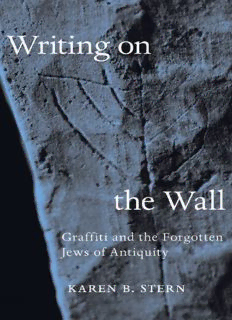Table Of ContentWriting on the Wall
Writing on the Wall
GRAFFITI AND THE FORGOTTEN JEWS OF ANTIQUITY
Karen B. Stern
Princeton University Press
Princeton and Oxford
Copyright © 2018 by Princeton University Press Published by Princeton University Press,
41 William Street, Princeton, New Jersey 08540
In the United Kingdom: Princeton University Press,
6 Oxford Street, Woodstock, Oxfordshire OX20 1TR
press.princeton.edu
Jacket image: Carving of menorah from a doorway inside a burial cave in the
Necropolis of Beit Sheʾarim, Israel. Photo by Ezra Gabbay
All Rights Reserved
ISBN 978-0-691-16133-4
Library of Congress Control Number 2018936572
British Library Cataloging-in-Publication Data is available Publication of this book has been aided by a
grant from the von Bothmer
Publication Fund of the Archaeological Institute of America
This book has been composed in Adobe Garamond Pro and Gotham Printed on acid-free paper ∞
Printed in the United States of America
10 9 8 7 6 5 4 3 2 1
For my mother Barbara
and
For Ezra
CONTENTS
Illustrations ix
Preface xiii
Acknowledgments xvii
Abbreviations xxi
INTRODUCTION Graffiti, Ancient and Modern 1
CHAPTER 1 Carving Graffiti as Devotion 35
CHAPTER 2 Mortuary Graffiti in the Roman East 80
CHAPTER 3 Making One's Mark in a Pagan and Christian World 141
CHAPTER 4 Rethinking Modern Graffiti through Ancient 169
Notes 177
References 239
Index 269
ILLUSTRATIONS
I.1 Banksy mural on West 79th Street and Broadway in New York City,
USA.
I.2 Political stencil from Jaffa, Israel.
I.3 Anti-Nazi graffiti on wall in downtown Erfurt, Germany.
I.4 Dedicatory inscription from floor mosaic of Susiya Synagogue in
Susiya, West Bank.
I.5 Shutter portrait of Rabbi Yosef Hayim ben Eliyahu of Baghdad (a.k.a.
Ben Ish ?ai) in Mahane Yehudah market, Jerusalem, Israel.
I.6 Tags on abandoned storefront in Lower East Side, New York City.
I.7 Menorah and showbread graffiti in Israel Museum in Jerusalem, Israel.
1.1 Dipinti and graffiti on columns of façade of Church of the Holy
Sepulchre in Jerusalem.
1.2 Graffiti of crosses along the stairway to St. Vartan’s Chapel in the
Church of the Holy Sepulchre.
1.3 West wall of the Dura-Europos Assembly Hall in situ following
excavation in Syria.
1.4 Aramaic memorial graffito from the Dura-Europos synagogue.
1.5 Greek memorial graffito from the Dura-Europos synagogue.
1.6 Aramaic memorial dipinto and accompanying picture from the Dura-
Europos synagogue.
1.7 Dedicatory inscription painted onto ceiling tile from Dura-Europos
synagogue.
1.8 Detail of Persian scribal dipinti on mural depicting the Triumph of
Mordechai from the assembly hall of the Dura-Europos synagogue.
1.9 The Paneion shrine and desert landscape of El-Kanaïs, Egypt.
1.10 (Top) Photo of Theodotos inscription in situ beside others of similar
type on rock face within the sanctuary of Paneion; (bottom) squeeze
impression of Theodotos inscription from rock face within the sanctuary
of Paneion in El-Kanaïs.
1.11 Modern prayer space in Elijah’s Cave on Mt. Carmel, Haifa, Israel.
1.12 Painted christogram overlying Greek inscriptions in Elijah’s Cave on
Mt. Carmel, Haifa, Israel.
1.13 (Top) Menorah carvings and Arabic inscription in Elijah’s Cave;
(bottom) tracing of menorah carvings and Arabic inscription in Elijah’s
Cave.
1.14 Graffito with menorah from Ein Hudera, Sinai.
2.1 Restored tomb of Marie Laveau in St. Louis Cemetery No. 1, New
Orleans, LA, USA.
2.2 Façade of Catacomb 20 in Beit Shearim, Israel.
2.3 (Top) Admonition to “be of good courage!” in graffito in Beit Shearim;
(bottom) tracing of message to “be of good courage!” in graffito in Beit
Shearim.
2.4 (Top) Message wishing “Good luck in your resurrection” in graffito in
Beit Shearim; (bottom) tracing of “Good luck in your resurrection” in
graffito from Beit Shearim.
2.5 Figural and architectural graffiti in Beit Shearim.
2.6 Abstract structural and architectural graffiti in Beit Shearim.
2.7 Ship graffiti in Beit Shearim.
2.8 Hebrew alphabet list in Beit Shearim.
2.9 (Top) Vulture/eagle on doorjamb in Beit Shearim; (bottom) tracing of
vulture/eagle on doorjamb in Beit Shearim.
2.10 Menorah graffito on doorjamb in Beit Shearim.
2.11 Greek graffiti on doorjamb in Beit Shearim.
2.12 Graffito of quadruped on internal doorjamb in Beit Shearim.
2.13 Greek and Aramaic curses around tomb in Beit Shearim; (bottom, in
situ). Detail of Greek curse (top left) and Aramaic curse (top right).
2.14 Painted curse threatening, “Whosoever changes this lady’s place,” in
Beit Shearim.
2.15 Skeleton carving in Beit Shearim.
2.16 Ship carvings from Beit Shearim.
2.17 (Top) Stacked human figures carved and painted inside arcosolium in
Beit Shearim; (bottom) detail of stacked human figures carved and
painted inside arcosolium in Beit Shearim.
2.18 Gladiator or combatant graffiti in Beit Shearim.
2.19 Combatant graffiti in Beit Shearim.
2.20 Scene of diving man with quadrupeds in Beit Shearim.
2.21 Skeleton and obelisks in entryway of burial hall in Beit Shearim.
2.22 Graffiti including grid, retrograde inscription, and obelisk on vestibule
wall in Horvat Lavnin, Israel.
2.23 X graffiti inside box shapes in Beit Shearim.
2.24 Drawing of ships on vestibule wall of Jason’s Tomb, Jerusalem, Israel.
2.25 (Top) Photo of ship graffiti from the Moustafa Pasha catacomb in
Alexandria, Egypt; (bottom) drawing of ship graffiti from the Moustafa
Pasha catacomb.
2.26 Ship carving from Torlonia Catacombs in Rome, Italy.
2.27 Drawings of combatant figures in burial cave of Tel ‘Eitun in the
Judean Shefelah, Israel.
2.28 Drawing of grid inside tomb in Bethphage, Israel.
3.1 Seat inscription from the theatre of Miletos, Turkey.
3.2 Seat inscription from the Bouleterion/Odeon of Aphrodisias, Turkey.
3.3 Menorah carving from the South Portico (Sebasteion) in Aphrodisias.
3.4 Menorah carving from the South Agora in Aphrodisias.
3.5 Painted place-holder (topos) inscription of Matrona from shops within
the Hippodrome of Tyre, Lebanon.
4.1 Street art depicting the “Third Temple” in Jerusalem, Israel.
Description:Few direct clues exist to the everyday lives and beliefs of ordinary Jews in antiquity. Prevailing perspectives on ancient Jewish life have been shaped largely by the voices of intellectual and social elites, preserved in the writings of Philo and Josephus and the rabbinic texts of the Mishnah and T

